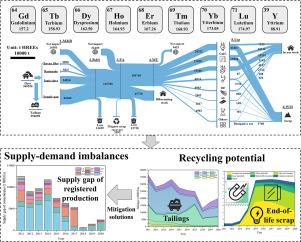通过群代谢分析推进中国重稀土元素可持续管理
IF 11.2
1区 社会学
Q1 ENVIRONMENTAL STUDIES
引用次数: 0
摘要
重稀土元素(hree)是低碳能源系统和数字经济技术不可或缺的元素。然而,很少有研究对不同的hree进行综合分析,这限制了制定有效的政策来提高整体的hree效率。本文采用动态物质流分析方法,对2011-2020年中国9种hree的全生命周期流量和库存量进行了研究。研究结果揭示了这些ree之间不同的供需动态。镝和铽呈现高临界状态,供应短缺;钇、铥和镥随库存量波动呈中等临界状态;而钆、铒、镱和钬则随存量积累呈现低临界状态。尽管中国主导着全球稀土生产,但它仍然严重依赖从缅甸进口,到2020年,缅甸占中国稀土化合物进口的90%。从尾矿中回收是一种立即可用的二次来源,可能取代中国高达58%的镝和46%的铽精矿供应。相比之下,回收废旧产品是一个长期的解决方案,磁铁材料的回收将在2037年左右达到峰值。这些发现为支持可持续的HREE管理提供了战略见解,包括根据每个HREE的临界水平制定特定元素的战略,主要供应来源的多样化,促进循环经济,以及加强信息治理以监测HREE流动。本文章由计算机程序翻译,如有差异,请以英文原文为准。

Advancing sustainable management of heavy rare earth elements in China through group metabolism analysis
Heavy rare earth elements (HREEs) are indispensable to low-carbon energy systems and digital economy technologies. However, few studies have provided a holistic analysis integrating different HREEs, which limits the development of effective policies to improve the overall HREEs efficiency. By applying a dynamic material flow analysis method, this study investigates the flows and stocks of nine HREEs across their life cycles in China for the period of 2011–2020. Results reveal different supply–demand dynamics among these HREEs. Dysprosium and terbium show high criticality with registered supply shortages; yttrium, thulium, and lutetium show medium criticality with stock fluctuations; while gadolinium, erbium, ytterbium, and holmium show low criticality with stock accumulation. Although China dominates global HREEs production, it remains heavily reliant on imports from Myanmar, which accounted for 90 % of its HREEs compounds imports in 2020. Recycling from tailings presents an immediately available secondary source, potentially substituting up to 58 % of China's dysprosium and 46 % of terbium concentrate supplies. In contrast, recycling from end-of-life products is a long-term solution, with recovery from magnet materials peaking around 2037. These findings offer strategic insights to support sustainable HREEs management, including the preparation of element-specific strategies based on the criticality level of each HREE, the diversification of primary supply sources, the promotion of circular economy, and enhanced information governance to monitor HREEs flows.
求助全文
通过发布文献求助,成功后即可免费获取论文全文。
去求助
来源期刊

Environmental Impact Assessment Review
ENVIRONMENTAL STUDIES-
CiteScore
12.60
自引率
10.10%
发文量
200
审稿时长
33 days
期刊介绍:
Environmental Impact Assessment Review is an interdisciplinary journal that serves a global audience of practitioners, policymakers, and academics involved in assessing the environmental impact of policies, projects, processes, and products. The journal focuses on innovative theory and practice in environmental impact assessment (EIA). Papers are expected to present innovative ideas, be topical, and coherent. The journal emphasizes concepts, methods, techniques, approaches, and systems related to EIA theory and practice.
 求助内容:
求助内容: 应助结果提醒方式:
应助结果提醒方式:


